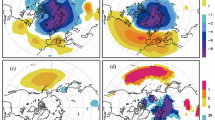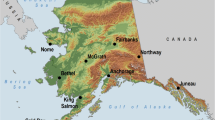Abstract
The occurrence of daily air temperature extremes in winter in Central Spitsbergen in the period 1975–2008 was analysed. The mean winter temperature was found to be increasing by approximately 1.65°C per decade. Negative extremes were becoming less frequent, decreasing at a rate of approximately 5 days per decade, whereas the frequency of positive extremes showed a small (2 days per decade) but insignificant positive trend. Furthermore, circulation patterns responsible for positive and negative temperature extremes were analysed. Composite maps of the sea level pressure (SLP) and 500-hPa geopotential heights (z500 hPa) means and anomalies were constructed for the days with positive and negative extremes. Circulation patterns causing extremely warm winter days are characterised by a cyclonic centre or a low pressure trough over the Fram Strait. Cyclones located west of Spitsbergen with a warm sector over the archipelago bring warm air masses from the southern quadrant. On extremely cold days, the cyclone centres are usually located over the Barents Sea. This SLP pattern implies airflow from the north and northeast that brings cold Arctic air to the North Atlantic. Another factor in the occurrence of the temperature extremes in Central Spitsbergen is the sea-ice cover. Negative temperature extremes usually occur together with a high concentration of sea ice, particularly in the middle and end of winter.









Similar content being viewed by others
References
ACIA Scientific Report 2005 Cambridge University Press, Cambridge
ACSYS (2003) ACSYS Historical Ice Chart Archive (1553–2002). 2 CD set, issued by the Intl. ACSYS/CliC Project Office, Tromsø, Norway (http://acsys.npolar.no)
Alekseev GV, Podgorni IA, Svyashchennikov PN, Khrol WP (1991) Features of climate formation and its variability in the polar climatic system atmosphere-sea ice-ocean. In: Krutskich BA (ed) Klimaticheskii rezhim Arktiki na rubezhe XX I XXI vv. Gidrometeoizdat, Sankt-Petersburg, pp 4–29 (in Russian)
Birkeland KW, Mock CJ (1996) Atmospheric circulation patterns associated with heavy snowfall events, Bridger Bowl, Montana, U.S.A. Mt Res Dev 16:281–286
Brázdil R (1988) Variation of air temperature and atmospheric precipitation in the region of Svalbard. In: Brázdil R et al (eds) Results of investigations of the geographical research expedition Sspitsbergen 1985. University J.E. Purkyne, Brno, pp 285–323
Comiso JC (2003) Warming trends in the Arctic from clear-sky satellite observations. J Climate 16(21):3498–3510
Esteban P, Jones PD, Martin-Vide J, Mases M (2005) Atmospheric circulation patterns related to heavy snowfall days in Andorra, Pyrenees. Int J Climatol 25:319–329
Førland EJ, Hanssen-Bauer I, Nordli PØ (1997) Climate statistics and long term series of temperature and precipitation at Svalbard and Jan Mayen. DNMI—Rapport, 21/97. Norwegian Meteorological Institute, Oslo
Hanssen-Bauer I, Forland EJ (1998) Long-term trends in precipitation and temperature in the Norwegian Arctic: can there be explained by changes in atmospheric circulation patterns? Clim Res 10:143–153
Hurrell JW (1995) Decadal trends in the North Atlantic Oscillation: regional temperatures and precipitation. Science 269:676–679
IPCC Fourth Assessment Report (2007) Working Group I Report “The Physical Science Basis”. Chapter 10. Global Climate Projections. Cambridge University Press, Cambridge
Johannesen OM, Bengtsson L, Miles MW, Kuzmina SI, Semenov VA, Alekseev GV, Nagurnyi AP, Zakharov VF, Bobylev LP, Pettersson LH, Hasselman K, Cattle HP (2004) Arctic climate change: observed and modeled temperature and sea-ice variability. Tellus 56A:328–341
Jolliffe IT (1993) Principal component analysis: a beginner’s guide—II. Pitfalls, myths and extensions. Weather 48:246–253
Kalkstein LS, Tan G, Skindlov JA (1987) An evaluation of three Clustering procedures for use in synoptic climatological classification. J Clim Appl Meteorol 26:717–730
Kalnay E, Kanamitsu M, Kistler R, Collins W, Deaven D, Gandin L, Iredell M, Saha S, White G, Woollen J, Zhu Y, Leetmaa A, Reynolds R, Chelliah M, Ebisuzaki W, Higgins W, Janowiak J, Mo KC, Ropelewski C, Wang J, Jenne R, Joseph D (1996) The NMC/NCAR 40-year reanalysis project. Bull Am Meteorol Soc 77:437–471
Maciejowski W, Michniewski A (2007) Variations in weather on the east and west coasts of South Spitsbergen, Svalbard. Pol Polar Res 28(2):123–136
Moritz RE, Bitz CM, Steig EJ (2002) Dynamics of recent climate change in the Arctic. Science 297:1497–1502. doi:10.1126/science.1076522
Morton O (1998) The storm in the machine. New Sci 157(2119):22–27
Niedźwiedź T (2003) Współczesna zmienność cyrkulacji atmosfery, temperatury powietrza i opadów atmosferycznych na Spitsbergenie (Contemporary variability of atmospheric circulation, temperature and precipitation in Spitsbergen). Probl Klimatol Polarn 13:79–92 (in Polish)
Niedźwiedź T (2006) Główne cechy cyrkulacji nad Spitsbergenem (XII.1950–IX.2006) (The main forms of atmospheric circulation above Spitsbergen. December 1950–September 2006). Probl Klimatol Polarn 16:91–105 (in Polish)
Nordli PØ (1990) Temperature and precipitation series at Norwegian Arctic meteorological stations. DNMI KLIMA. Rapport 40(90):1–14
Polyakov IV, Bekryaev RV, Alekseev GV, Bhatt US, Colony RL, Johnson MA, Maskshtas AP, Walsh D (2003) Variability and trends of air temperature and pressure in the maritime Arctic 1875–2000. J Climate 16(12):2067–2077
Przybylak R (1996) Zmienność temperatury powietrza i opadów atmosferycznych w okresie obserwacji instrumentalnych w Arktyce (Variability of air temperature and precipitation over the period of instrumental observations in the Arctic). Uniwersytet Mikołaja Kopernika, Toruń
Przybylak R (2000) Temporal and spatial variation of surface air temperature over the period of instrumental observations in the Arctic. Int J Climatol 20(6):587–614
Przybylak R (2002) Variability of air temperature and atmospheric precipitation in the Arctic. Kluwer Academic Publishers, Dordrecht
Przybylak R (2003) The climate of the Arctic. Kluwer Academic Publishers, Dordrecht
Przybylak R (2007) Recent air-temperature changes in the Arctic. Ann Glaciol 46:316–324
Rogers JC (1985) Atmospheric circulation changes associated with the warming over the northern North Atlantic in the 1920s. J Clim Appl Meteorol 24:1303–1310
Rogers JC, Yang L, Li L (2005) The role of Fram Strait winter cyclones on sea ice flux and on Spitsbergen air temperatures. Geophys Res Lett 32:L06709, 4 pp. doi: 10.1029/2004GL022262
Serreze MC, Barry RG (1988) Synoptic activity in the Arctic Basin 1979–85. J Climate 1(12):1276–1295
Serreze MC, Box RG, Barry RG, Walsh JE (1993) Characteristics of arctic synoptic activity. Meteorol Atmos Phys 51(3):147–164
Steffensen EL (1982) The climate at Norwegian Arctic stations,. Det Norske Meteorologiske Institutt, Klima nr.5, Oslo
Styszyńska A, (2005) Przyczyny i mechanizmy współczesnego (1982–2002) ocieplenia atlantyckiej Arktyki (Causes and mechanisms of present (1982–2002 warming of the Atlantic part of the Arctic). Wydawnictwo Uczelniane Akademii Morskiej w Gdyni
Tuomenvirta H, Alexandersson H, Drebs A, Frich P, Nordli PØ (2000) Trends in Nordic and Arctic temperature extremes and ranges. J Climate 13(3):977–990
Turner J, Overland JE, Walsh JE (2006) An Arctic and Antarctic perspective on recent climate change. Int J Climatol 27(3):277–293
Ustrnul Z, Czekierda D (2009) Atlas of extreme meteorological phenomena and synoptic situations in Poland. Instytut Meteorologii i Gospodarki Wodnej, Warsaw
Ward JH (1963) Hierarchical grouping to optimize an objective function. J Am Stat Assoc 58:236–244
Wielbińska D, Skrzypczak E (1988) Mean air temperature at definite wind directions in Hornsund, Spitsbergen. Pol Polar Res 9(1):105–119
Yarnal B, Comrie AC, Frakes B, Brown DP (2001) Developments and prospects in synoptic climatology. Int J Climatol 21:1923–1950
Zhang X, Walsh JE, Zhang J, Bhatt US, Ikeda M (2004) Climatology and inter-annual variability of Arctic cyclone activity: 1948–2002. J Climate 17:2300–2317
Author information
Authors and Affiliations
Corresponding author
Rights and permissions
About this article
Cite this article
Bednorz, E. Occurrence of winter air temperature extremes in Central Spitsbergen. Theor Appl Climatol 106, 547–556 (2011). https://doi.org/10.1007/s00704-011-0423-y
Received:
Accepted:
Published:
Issue Date:
DOI: https://doi.org/10.1007/s00704-011-0423-y




